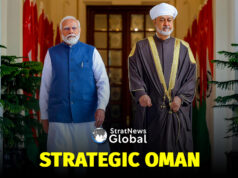NEW DELHI: An excerpt from ‘Talking Point‘, with Amitabh Mattoo, Professor, CIPOD, SIS, Jawaharlal Nehru University, Honorary Professor, University of Melbourne, Founding Director, Australia India Institute, Ex-Member of India’s National Security Advisory Board and Natasha Jha Bhaskar, General Manager, Newland Global Group in discussion with StratNews Global Associate Editor Amitabh P. Revi.
Transcript:
APR: If you want to just wrap up your thoughts with a thought that Natasha brought up earlier in terms of the Australian Trade Minister saying when he was in the U.S., he’s spoken with the USTR, was in touch with UK counterparts, Canada counterparts. Is this a template that can be followed, even if not necessarily straight-jacketed, but things that were problems before and have been resolved here? Can India hold them out for the U.S., the UK to get everyone else see, this can be done?
AM: I think that’s the biggest signal, because I saw commentators from the UK say oh the biggest thing about this deal is that India signed it. That India is such a reluctant deal maker, that to get India to actually sign off on a bilateral trade agreement is an achievement by itself. And this does serve as a model or as a template, of course circumstances are different. Economies are different. But, certainly with countries with which you also share other things. For instance, Israel, UAE, Canada, UK. And I know the External Affairs Minister Dr. Jaishankar spoke about how the pie relationships, which have transformed during the Modi years are Japan, Australia, UAE, Israel, and of course the United States. Add UK and Canada to them, and you can see that while strategically, there is a greater true closeness and convergence, if you could actually give these relationships more economic depth, then there will be a momentum which will be far greater than what could be provided only through the political convergences. So, yes, this is a signalling that India is ready to sign on to deals, even though it’s not patently obvious, that there are as Salvatore said huge gains. But, I believe that there are huge gains. And that it is willing to actually compromise on certain sectors, if need be. And that these deals are fully compliant with WTO rules and guidelines and GATT rules, regarding free trade deals. So, while India might still be uncomfortable with sub-regional multilateral economic arrangements, which are dominated by one big path, because obviously your influence to be able to negotiate an agreement in a multilateral framework, where you are not the dominant partner is much lesser. Therefore India values bilateral trade deals much more. It’s important now for other countries to pick on this moment. Australia has shown the way. It’s for others now, to see this as a window open or a door open and walk into it.
APR: Natasha, if you want to just wrap up your thoughts on this particular episode.
NJB: I’ll go back to where we started. About Prime Minister Modi’s visit to Australia in 2014, after a gap of 28 years, and where he announced in the joint session of parliament in Canberra that Australia was no longer at the periphery of India’s vision but at the centre of its thoughts. It seems like that’s turning into a reality now, in terms of engagement that’s happening across different sectors. And being part of the Australian Indian diaspora, I would say that the diaspora is also equally excited and enthusiastic about engaging. Australia has also released a categorical diaspora report to identify and map the diaspora potential because there’s this clear understanding that the network skills and capabilities that the diaspora can bring to Australia to really take this relationship to the next level is of great use. And that’s something which needs to be harnessed. So diaspora dormancy is another component of this relationship, which is being explored at a big level. But overall, the key message is not to look at this relationship from a buyer-supplier partnership, from a buyer-supplier viewpoint. it has to be capacity driven. It has to be from a model where Australia has a development anchor kind of a model for India, which is aspirational, which is growing and is looking for partnerships. Not just for basic trade engagement. And that sort of shift is happening with all the energy which we are seeing around.




